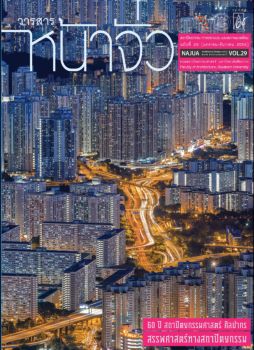การศึกษาคุณภาพเชิงทัศน์เพื่อวางแผนการจัดการสิ่งแวดล้อมภูมิทัศน์: กรณีศึกษาเทศบาลเมืองหัวหิน
คำสำคัญ:
การประเมินคุณภาพเชิงทัศน์, มลทัศน์, เขตจัดการทางสายตา, ความเป็นสถานที่, หัวหิน, Visual Quality Assessment, Visual Pollution, Visual Management Zone, Sense of Place, Hua Hinบทคัดย่อ
หัวหินเป็นเมืองตากอากาศชั้นนำของประเทศไทย มีชายหาดที่สวยงาม ประวัติความเป็นมาที่โดดเด่น เป็นเมืองเล็กที่สงบ สวยงาม และเป็นที่ตั้งวังไกลกังวลอันเป็นที่ประทับฯ ด้วยระยะทางที่ไม่ไกลจากกรุงเทพมหานคร ทำให้ได้รับความนิยมอย่างสูง เกิดการพัฒนาอสังหาริมทรัพย์ประเภทที่อยู่อาศัย พาณิชยกรรม และอื่นๆมากมายและรวดเร็วจนทำให้เกิดปัญหาหลายด้าน ปัญหาที่สำคัญเรื่องหนึ่งคือคุณค่าความสวยงามของเมืองและธรรมชาติที่เสื่อมทรามลงอย่างรวดเร็วจากความหนาแน่นที่เพิ่มขึ้นอย่างไร้ทิศทางงานวิจัยนี้มุ่งศึกษาทำความเข้าใจคุณภาพเชิงทัศน์ของส่วนสำคัญของเมืองหัวหิน และทัศนคติของคนที่มีต่อสภาพแวดล้อมกายภาพที่มีคุณค่าเหล่านั้น เพื่อใช้ผลการศึกษาในการหาแนวทางที่เหมาะสมเพื่อการพัฒนากายภาพที่เหมาะสมและไม่ลดคุณค่าความงามของเมืองหัวหินในอนาคต
วิธีการวิจัยเริ่มจากการศึกษาความเป็นมาของเมือง สถานที่สำคัญ และความหมาย จากนั้นทำการสำรวจในพื้นที่ด้วยการสังเกตกายภาพและกิจกรรม กำหนดโครงสร้างจินตภาพของเมืองและแบ่งเป็นย่านเชิงทัศน์ (Visual Zone) คือบริเวณที่มีความคล้ายคลึงทางด้านกายภาพและกิจกรรมจนคนส่วนใหญ่รับรู้ว่าเป็นย่านเดียวกัน แบ่งออกได้เป็น 6 ย่านที่สำคัญและใช้เป็นพื้นที่ศึกษา จากนั้นเก็บบันทึกภาพถ่ายของแต่ละย่าน เลือกหาภาพตัวแทนที่เหมาะสมของแต่ละย่านได้ภาพทั้งหมด 36 ภาพ สร้างแบบสอบถามประกอบรูปภาพ (Photo-Questionnaire) เพื่อให้กลุ่มตัวอย่างให้คะแนนภาพทีละภาพ เพื่อแสดงความชอบภาพและความรู้สึกว่าภาพนั้นแสดงความเป็นหัวหิน บน Likert Scale 5 จุด และถามเหตุผลและทัศนคติอื่นๆ รวมถึงลักษณะส่วนตัว กำหนดกลุ่มตัวอย่างแบบโควตาตามชั้นตัวอย่าง (Stratified Quota Sampling) เพื่อให้ครอบคลุมคนไทยทั้งคนหัวหินและคนไทยที่อื่นๆ คนต่างชาติที่เป็นนักท่องเที่ยว เจ้าหน้าที่เทศบาลเมือง และผู้มีอาชีพในการออกแบบ เก็บข้อมูลด้วยการสัมภาษณ์โดยใช้แบบสอบถาม
ผลจาการวิเคราะห์ข้อมูลแสดงให้เห็นทัศนคติของผู้ตอบแบบสอบถาม 285 คนว่าความชอบและความเป็นหัวหินสัมพันธ์กันใกล้ชิด กล่าวคือคนจะชอบมากหากภาพแสดงความเป็นหัวหินสูง ภาพที่ชอบที่สุดตามลำดับคือภาพชายทะเล อาคารที่มีความเป็นมาทางประวัติศาสตร์ที่สำคัญ ได้แก่ สถานีรถไฟและโรงแรมรถไฟ บริเวณที่มีธรรมชาติที่ชอบน้อยลงคือ ชายหาดที่มีอาคารสูง ย่านท่องเที่ยว ย่านกลางเมือง บริเวณที่ไม่ชอบคือ ถนนทางเข้าเมือง และตลาดสดกลางเมือง ผลจากการศึกษาเบื้องลึกแสดงให้เห็นว่าความพิเศษของหัวหินอยู่ที่ธรรมชาติที่สวยงามและสิ่งก่อสร้างทางประวัติศาสตร์ที่ผสมผสานกันเป็นหนึ่งเดียว การพัฒนาใหม่ๆในช่วงหลังไม่เป็นที่นิยมและไม่สามารถแสดงออกถึง ความเป็นหัวหิน
ผลการศึกษานำไปสู่แนวทางเสนอแนะการปรับปรุงกายภาพของแต่ละย่านเพื่อปกป้อง และส่งเสริมคุณภาพพิเศษทางกายภาพดังกล่าว และควบคุมการพัฒนาทางกายภาพใหม่ๆที่จะทำให้คุณค่านั้นลดลงไปในอนาคต
A Study of Visual Quality for Management of Visual Environment: A Case of Hua Hin Municipality
Rujiroj Anambutr, Ph.D.
Assistant professor, Faculty of Architecture, Silpakorn University
Wilasinee Suksawang
Lecturer, Faculty of Architecture, Chulalongkorn University
Hua Hin, a famous beach town in Thailand, with its beautiful shoreline, meaningful history, small town elegance, and a place where the royal retreat, Klai Kangwon Palace, is situated, has certainly earned its name as a popular destination not very far from Bangkok. In recent years, Hua Hin has seen an intense growth in commercial and residential real estate sectors which have led to various kinds of problems. A significant one involves deterioration of town appearance and natural environment from such widespread and intense development.
The research primary objective is to study and provide an understanding of visual quality of Hua Hin’s major elements and human attitude toward physical environment. The results will be used for analysis to harness suitable measures for physical development that will not recede the value of town appearance in the future.
Research methodology begins with a review of town history, important places, and their significance. Later, site surveys are conducted to observe physical conditions and ongoing activities. A cognitive or mental structure is then conducted as a basis for determining visual zones; an area or district with a perceivable harmonious physical environment and activity. Six visual zones are determined and used as areas of study. Photo-questionnaire is constructed using 36 selected pictures that represent visual zones. Respondents are asked to rate on a five-pointed Likert Scale, their liking toward each picture and their opinion on each picture as a representation of the sense of “being Hua Hin”. Finally, stratified quota sampling is used on identified groups of population, including Thai residents living in Hua Hin, Thai residents not living in Hua Hin, foreigners, municipal officers, and design professionals.
Results from analysis of 285 respondents indicate a close relationship between respondents’ liking toward each picture and their opinion on each picture as a representation of the sense of “being Hua Hin”. In other words, the better the picture expresses “being Hua Hin”, the more the respondent likes it. Among these, the most liked pictures are pictures of the beach, historical landmarks (i.e., the railway station and the railway hotel), and natural area, respectively. While the least liked pictures are those of beach with presence of high-rise buildings, tourist area, downtown area, main street, and local market. Deeper investigation reveals that Hau Hin’s uniqueness is an integration of its natural beauty and historical architecture, while newer developments are unfavorable and not able to represent Hua Hin’s image.
The results of the study lead to recommendations on physical improvement of each zone intending to protect as well as to enhance Hua Hin’s special visual quality and control future developments that might devalue its uniqueness.





